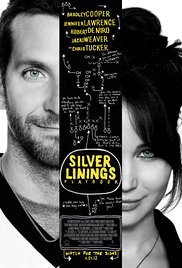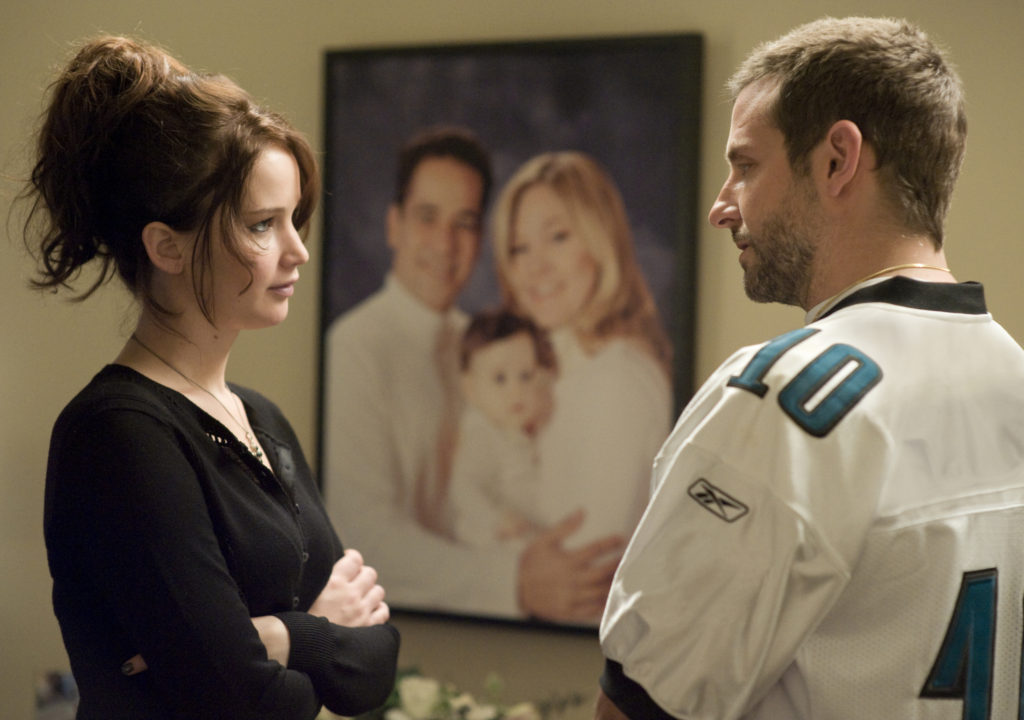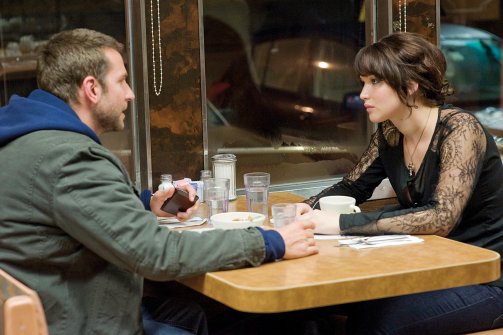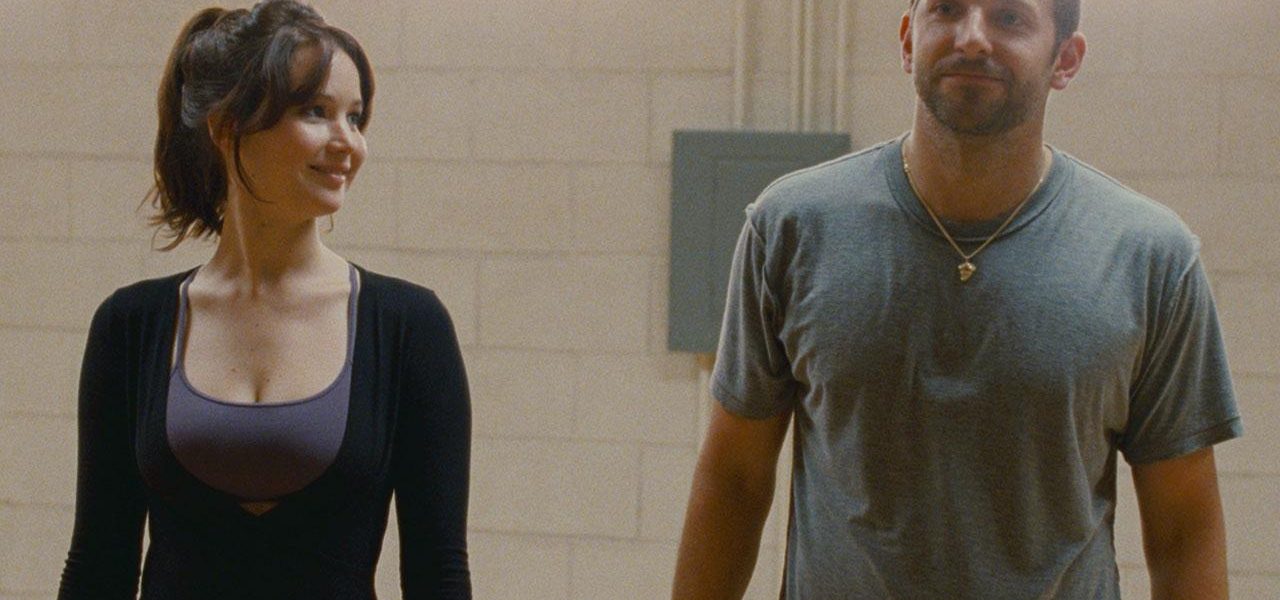Calling An Audible In The Third Act
DIRECTED BY DAVID O. RUSSELL/2012
 Full disclosure: I did not see the entirety of Silver Linings Playbook; two minutes had to be sacrificed to the bladder gods. But I did not choose my moment of relief randomly. I stole away at the end of what I felt was the most contrived scene up for an Oscar this year. A scene so wacky, a scene so “hey, it’s a movie, relax,” that Director/Writer David O. Russell could not buy enough lanterns to hang on it. A scene that successfully takes the stark yet sweet family-drama/misfit-love tone of the first two thirds of the movie, and judo flips it into a hillock of the saccharine hot fudge zaniness that only Hollywood and psychedelic drugs can supply. I’m talking “parlay.” I’ll get to that scene later. First, let’s familiarize ourselves with the story.
Full disclosure: I did not see the entirety of Silver Linings Playbook; two minutes had to be sacrificed to the bladder gods. But I did not choose my moment of relief randomly. I stole away at the end of what I felt was the most contrived scene up for an Oscar this year. A scene so wacky, a scene so “hey, it’s a movie, relax,” that Director/Writer David O. Russell could not buy enough lanterns to hang on it. A scene that successfully takes the stark yet sweet family-drama/misfit-love tone of the first two thirds of the movie, and judo flips it into a hillock of the saccharine hot fudge zaniness that only Hollywood and psychedelic drugs can supply. I’m talking “parlay.” I’ll get to that scene later. First, let’s familiarize ourselves with the story.
Pat Solitano (Bradley Cooper) has just been released from an eight and a half month stay at a mental institution after delivering a bi-polar influenced beat down on the history teacher at the school he used to work for. He’s lost weight and reading books in hopes of reconnecting with his estranged wife, Nikki, an apparent mute who he caught in the shower with the aforementioned history teacher. We feel genuine sympathy for Pat since he seems sincere in his desire to win back his wife. Pat’s dad, Pat Sr. (Robert DeNiro), is a wistfully emotionally-present father who suffers from undiagnosed obsessive-compulsive disorder and bad judgment. His mom Dolores (Jacki Weaver) seems to typify the powerless housewife who retreats to the kitchen when she can’t stand the heat in the living room. We spy on tense domestic scenes. Pat’s mental illness only aggravates the stress of his idiosyncratic yet strangely typical family dynamic. Pat and his dad land punches. Mom cries. The cops show up. While there are lighthearted respites, Pat’s mental anguish is never played up for laughs. There is a certain horror in watching a mentally ill person lose his grip on reality.
But that isn’t the only dynamic on display. Pat’s loyal friend Ronnie is ecstatic to see Pat again. As revealed in a wonderful “awkward dinner” scene, Ronnie is trapped under a mountain of debt and a demanding wife; he envies Pat’s freedom. At this same dinner Pat meets Tiffany (Jennifer Lawrence), a young widow with a sexual history that reveals deep emotional issues.

Possibly the greatest family portrait ever featured in a movie.
Every sympathetic character in the movie seems to be trying to pay off some debt, repent for some sin. Prove himself or herself to the world. Parents feel like they could have done more. Children feel like they weren’t good enough or never will be. Husbands feel trapped. Wives just don’t feel.
And then there’s a dance competition.
Now, the movie doesn’t just devolve into some surreal Bollywood celebration with Ewoks chumbawumbing about. We’re introduced to the dancing conceit through the budding relationship between Pat and Tiffany. She is processing her pain through dance and recruits the somewhat inaccessible Pat to be her partner. Pat is still deeply in love with his estranged wife and believes this dance competition will be the proof to her that he’s changed. Tiffany effectively convinces him to participate with a forged note that is ostensibly from Pat’s wife. Pat and Tiffany grow closer together and understand each other in a way that only messed up people can. We’re all messed up in our own way. But there’s always silver lining.™
But then there’s a dance competition. And possibly the happiest ending this side of Endor. You see, if Pat Jr and Tiffany win the dance competition AND the Eagles beat the Cowboys then Dad gets to open up his restaurant with the dirty money that he lost on his previous bet. Oh, and he lost that bet because of Pat Jr and Tiffany, for some superstitious reason or another. This is all explained in convincing yet absurd fashion in the infamous “parlay” scene that I so lovingly bemoan above.
Pat and Tiffany grow closer together and understand each other in a way that only messed up people can. We’re all messed up in our own way. But there’s always silver lining.™
Now there are a lot of people who love this scene (apparently Quentin Tarantino is one of them), so I’m not going to argue that it’s wrong to love a fun scene in a heartwarming movie. But for all the fine performances turned in by an ensemble cast committed to the script, the script cannot commit to its original tone.
Is the dance-off resolution completely invalid? No, this isn’t the first heartstrings movie to feature a game show-esque finale (twenty million Rupee!). Is it charming that the characters celebrate a “5”? Of course! You can be good enough with a 5! Is it a fun scene to watch? Yes! That part where he’s basically balancing her on his chin (to put it gently) was awkwardly hilarious!
But “winning” the dance competition is only resolving the fabricated plot point set up ten minutes before. The script jams in a Nikki appearance (remember her?) at the competition so that Tiffany has some sort of angst to resolve. And Pat is over his wife because the note that Tiffany forged was just the right kind of dishonest (as Pat praises her in the stunningly absurd line, “The only way you could meet my crazy was by doing something crazy yourself.”) It’s basically all the goofy parts of a rom-com scotch taped onto what was until that point a nuanced dramedy.

I’ll have the mental breakdown she’s having.
The original novel on which the movie is based brings us to basically the same ending but it only does so after much reconciliation between characters and resignation within Pat Jr. I know movies have to end somewhere and any movie not directed by Lars Von Trier has the opportunity to end happily. But to end so happily, so abruptly without the realities of mental illness and family dysfunction being woven into the denouement, that seems like the wrong kind of dishonest.
What about the fights between Dad and Jr brought on by the irrational randomness of bi-polar disorder and family dysfunction? What about Tiffany’s sexual pathology, Ronnie’s impending mental breakdown, and Mom’s baking pan escapism?
David O. Russell did not have to make the next Million Dollar Baby (the last movie that was up for the Big Five Academy Awards). He didn’t even have to make a more lighthearted version of A Beautiful Mind or The Soloist (the last two big Oscar movies that feature mental illness). But David O. Russell could have made the end of Silver Linings Playbook look like the rest of the movie. He could have made the characters struggle for resolution instead of simply dismissing their ailments and giving them everything they ever wanted (well, basically love and wads of cash). It could still have been uplifting. I understand that David O. Russell has a son who suffers from bi-polar disorder. I sense that familiarity in the first two acts of the movie, but I see that familiarity abandoned for the familiarity of Hollywood endings in the third act, unfortunately.
Early in the movie, Pat Jr. shatters the silence of a cozy suburban night by defenestrating a paperback copy of Hemingway’s A Farewell to Arms onto the front lawn. He complains to his parents about the excessively sad ending. But those who have read A Farewell to Arms know that’s the way the book had to end. And we have to be OK with sad endings when they do happen. That’s life.
For those of us who know people with mental illness or people struggling with sexual addiction, we know that there are no Hollywood endings, only struggles and respite. As it’s better understood, perhaps we will receive more great films that dare to explore more deeply mental illness’ and sexual addiction’s effects on relationships within the family and within society at large.
Since starring in Silver Linings Playbook, Bradley Cooper has involved himself in the discussion about mental health awareness. I commend his willingness to lend his fame to a nationwide discussion that has remained alarmingly dormant until recently. If you’d like to learn more about the reality and scope of serious mental illness please visit www.bringchange2mind.org.


